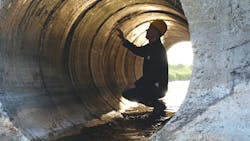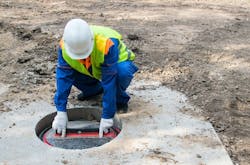Safety Equipment for Water & Wastewater Workers
About the author:
Gen Handley is marketing and growth coordinator for Tsunami Solutions and Scatterling. Handley can be reached at [email protected].
At the peak of the COVID-19 quarantine, a shocking number of U.S. businesses and services came to a jarring halt, forcing ourselves to stay at home and away from others, adjusting to the new normal. But during this chaotic time, did residents ever run out of clean water for cooking? Did showers ever stop working or toilets stop flushing? For many, they did not. This is because tens of thousands of dedicated wastewater workers toiled around the clock, making sure the public had non-stop access to clean, running water.
Wastewater workers face some of the highest number of safety hazards in any U.S. industry, including:
- Exposure to effluents and the reagents used in water processing and treatment that may cause acute poisoning, chemical accidents (skin burns, injury to the eyes, etc.), damage to the respiratory system, chronic diseases, dermatitis and allergies;
- Injuries from slips, trips and falls on wet floors, and drowning in treatment ponds, pits, clarifiers or vats;
- Burns and injury from hazardous chemical splashes;
- Cuts from sharp tools and equipment;
- Injuries working in confined, small spaces.
- Injuries and disfigurement from electric shock and burns;
- Injuries and death from explosions; and
- Injuries or disfigurement from entanglement of limbs in moving machinery.
A New, Invisible Threat
And with the relatively new, complicated threat of the deadly COVID-19 virus, utility workers, particularly those who work alone, have become even more vulnerable to safety risks. The Center for Disease Control and Prevention says that “there is no information to date that anyone has become sick with COVID-19 because of exposure
to wastewater.”
But the COVID-19 threat to wastewater workers comes from the new, less-obvious risks mostly due to new practices like social distancing. There are now more team members working alone and in isolation, leaving them more vulnerable than before the pandemic hit. The good news is that there are a number of steps that managers can take to address these hazards. These steps include enforcing basic hygiene practices, and providing thorough training in disease and accident prevention. But managers can also look to a growing selection of innovative technologies and personal protective equipment (PPE) to mitigate these dangers so that wastewater workers can continue to make sure the clean water in our communities keeps flowing.
Smart Glasses
Using goggles and protective eyewear is obvious in a job where workers are injured by flying debris and chemical or effluent splashes and sprays. Smart glasses take safety to the next level allowing managers to send maps, instructions, video and audio recordings to their lone workers.
Respiratory Equipment
This type of PPE is not used very often, but that could change with the new COVID-19 circumstances and the higher number of lone workers. Using this equipment will require training but is worth it as this type of PPE reduces the workers’ risk of contracting infectious illnesses.
Check-in System
When wastewater workers are on the job alone, it is important that they check in with the company at predetermined times to confirm they are safe. This can be done manually or through an automated system, which will send out an alert if a check-in is missed.
Advertisement
Cooling PPE
In the past, workers have used wet bandanas, face masks and other wearables to stay cool on hot days. A new cooling PPE technology is currently being developed, which takes advantage of evaporation’s natural cooling effect by using specially woven fabrics to ensure worker safety in hot summer conditions.
Flame & Water-Resistant Clothing
Working around water, extremely durable and water-resistant clothing is an obvious piece of equipment for wastewater work. On top of that, workers may also face chlorine, ammonia, methane and hydrogen sulfide build up, causing dangerous flash fires and explosions. This is why ample research is being done to develop lighter, cooler and more protective fireproof clothing and barrier coats.
Home-Testing Kits
While nothing has been commercialized yet, work is being done to develop a COVID-19 home antibody test kit that is affordable and provides results quickly. People who receive positive results on these tests but do not have symptoms of COVID-19 or have not been around someone who may have COVID-19, are not likely to have a current infection. They can continue to work but it still requires steps to protect themselves and others.
Smart Cameras
Another emerging technology is the development of smart cameras that can monitor, measure and display harmful gas leaks up to 2 miles away. There is hope that similar cameras will be developed to spot the many hazardous gases found in sewage and water treatment facilities.
Smart Helmets
Hard hats are no longer the simple, sturdy plastic objects that protect lone workers’ heads. The next generation of hard hats are equipped with LED lights, cameras and sensors that can measure important information like the worker’s temperature and oxygen levels in the brain.
Fall-Detection Technology
As mentioned earlier, slips, trips and falls are a common cause of injury in the water and wastewater industry. To address this problem, there have been a number of fall-detection solutions that utilize motion sensors to detect rapid movements toward the ground as well as extended periods of inactivity if a worker is unconscious or injured and unable to move.
Cut-Resistant Gloves
These types of gloves have been around for a while, but recently advances have been made, creating gloves that are both light and thin, while also protecting hands from sharp tools or equipment. This advanced handwear uses materials such as para-aramid, high performance polyethylene, and special polyvinyl acetate fabric.
Slip-Resistant Gloves
A common problem is handling wet or oily tools and machinery at the plant. Thankfully, work is being done to develop slip-resistant gloves that are coated in a material that deflects oil keeping hands dry as well as a layer that absorbs the oil, preventing saturation. They are functional, while remaining comfortable, light and durable.
Contact-Tracing
One of the most effective ways to combat the spread of COVID-19 in the workplace is to develop a contact-tracing system that can identify staff who are not practicing recommended safety measures, allowing supervisors to proactively identify staff who increase the risk of spreading COVID-19 to their co-workers.
If infection does occur, a contact-tracing system can identify with which workers the sick person was in contact and then isolate the situation. Contact tracing can be done manually or through an automated system.
Fatigue Monitoring
A common cause of workplace injury and error is workers becoming too tired to safely perform their tasks. To measure fatigue in a worker, monitors are being placed on clothing and headware to keep track of the worker’s eye and head movements. The goal of this technology is to prevent less injuries and vehicle damage from lone workers falling asleep.
Proactive Location Tracking
Whenever a lone worker—or any worker, for that matter—experiences an emergency or injury, the first piece of information needed is their location. The newest location tracking devices are lightweight and unobtrusive. For those who do not want to use extra devices, look at applying an automated tool that tracks location on existing mobile devices. Location tracking is important because in an emergency, every second counts.


